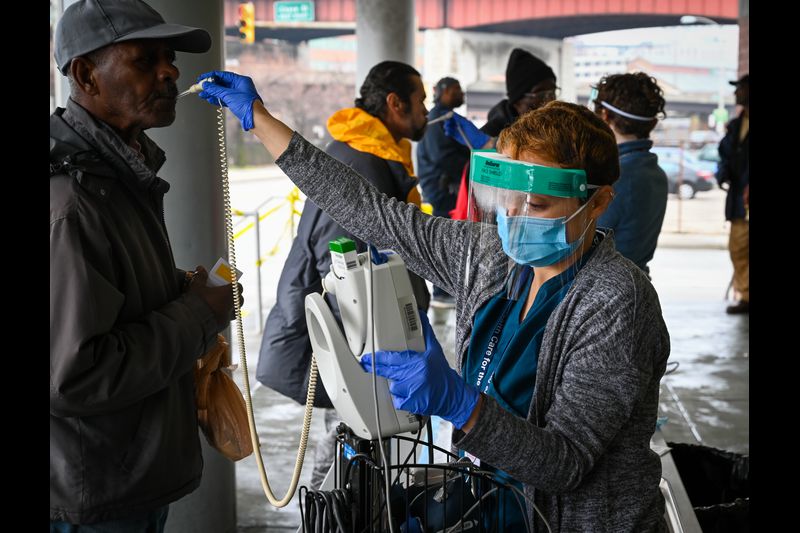This post is co-authored by Regina Reed, MPH, Policy Organizer at the National Health Care for the Homeless Council, and Chandra Crawford, Ph.D., Program and Policy Analyst at the National Alliance to End Homelessness.
Featured image photo: “On the porch of Health Care for the Homeless in Baltimore, MD, nurse, Molly Greenburg, takes a client’s temperature. (Photo: Jerry Jackson/Baltimore Sun)”
We are in the midst of a health crisis – the COVID-19 pandemic – where we know people experiencing homelessness are at a greater risk of infection due to a variety of factors like the inability to socially isolate, being unsheltered, and having increased underlying health conditions. While leaders in both housing and health fields have long dissected the relationship between housing and health care, COVID-19 has brought the connection into clear view.
To address the pandemic, the homelessness system must work across silos, particularly health – a sector that has the ability to test and care for our vulnerable populations during these trying times. Advocacy efforts must be coordinated to meet the varying needs of people experiencing homelessness that cut across both systems.
Just as our heroic homeless systems leaders, our shelter and outreach teams, etc. are on the front-lines, organizations like the National Health Care for the Homeless Council’s nationwide community of homeless health care providers are on the front lines of this pandemic too. Their clinics are extended to their full capacity -and beyond- to treat and protect people experiencing homelessness. These clinics are also struggling to obtain adequate testing, supplies, and protective equipment. Like many other businesses and nonprofits in this country, clinics are also facing budget and staffing stresses.
Beyond the implementation of disease prevention and treatment strategies, health care providers are limited in what they can do to prevent the spread of COVID-19 and keep others from falling into homelessness due to the impending economic downturn. This is where partnerships, strategic planning, and action are needed from systems leaders, elected officials, various government and community agencies. Immediate, coordinated action must be taken to protect homeless populations.
While our government typically works in silos — housing, food, health care, etc— we know the best way for an individual to escape homelessness is through support and coordination between many sectors. We also know that “fixing” homelessness, or preventing it in the long-term, requires major structural changes and robust investments in a wide range of programs.
This pandemic is making it hard to ignore the astounding disparities that fall upon those who are impoverished, people of color, and others who have been historically and systematically disenfranchised. The devastation of this pandemic is further evidence that housing and health care must be a human right.
Resources:
Find NHCHC’s COVID-19 Resources on its Landing Page, including guidance for policy makers, shelter and service providers, clinicians, and other resources:

